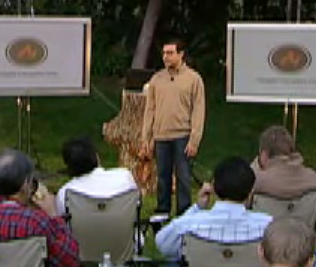 Two days ago, on the day of All Hallows (All Saints), Google announced OpenSocial a collection of APIs for embedded social applications. Actually much of the online documentation like the first OpenSocial API Blog entry didn’t go up until early in the morning on November 2nd after the Campfire talk. On November 1st they had their rather hokey Campfire One in one of the open spaces in the Googleplex. A sort of Halloween for older boys.
Two days ago, on the day of All Hallows (All Saints), Google announced OpenSocial a collection of APIs for embedded social applications. Actually much of the online documentation like the first OpenSocial API Blog entry didn’t go up until early in the morning on November 2nd after the Campfire talk. On November 1st they had their rather hokey Campfire One in one of the open spaces in the Googleplex. A sort of Halloween for older boys.

Screen from YouTube video. Note the campfire monitors.
OpenSocial, is however important to tool development in the humanities. It provides an open model for the type of energetic development we saw in the summer after the Facebook Platform was launched. If it proves rich enough, it will provide a way digital libraries and online e-text sites can open their interface to research tools developed in the community. It could allow us tool developers to create tools that can easily be added by researchers to their sites – tools that are social and can draw on remote sources of data to mashup with the local text. This could enable an open mashup of information that is at the heart of research. It also gives libraries a way to let in tools like the TAPoR Tool bar. For that matter we might see creative tools coming from out students as they fiddle with the technology in ways we can’t imagine.
The key difference between OpenSocial and the Facebook Platform is that the latter is limited to social applications for Facebook, as brilliant as it is. OpenSocial can be used by any host container or social app builder. Some of the other host sites that have committed to using is are Ning and Slide. Speaking of Ning, Marc Andreessen has the best explanations of the significance of both the Facebook Platform phenomenon and OpenSocial potential in his blog, blog.pmarca.com (gander the other stuff on Ning and OpenSocial too).